The Chinese Crested Powderpuff is the hairy version of the hairless Chinese Crested breed.
This unique and fluffy dog can be best described as a loving companion that is made for a variety of environments and prefers the couch to the outside world.
If you are considering to elect a Chinese Crested to be your best friend or if you are just interested in learning more about this exotic looking dog, then keep on reading for we will cover everything you need to know about the Powderpuff below.
Here are a few Chinese Crested Powderpuff facts at a glance:
Dog Breed Group: Toy Group
Life span: 10-13 years
Temperament: lively, affectionate, alert, playful
Height: 11-13 inches (28-33 cm)
Country of Origin: Africa, China, Mexico
Weight: 8-12 pounds (3,6-5 kg)
Recognition: ACA, ACR, AKC, ANKC, APRI, CKC, DRA, FCI, KCGB, NAPR, NKC, NZKC
Chinese Crested Powderpuff Temperament
The Chinese Crested Powderpuff is a member of the toy group and was originally bred to be a loving family companion, which he truly is!
Adjectives that would best describe this unique looking dog are lively, affectionate, loyal, gentle, and alert.
These dogs thrive in families with children where at least one member is always at home. They can be playful and energetic but also appreciate snuggles on the couch with their owner.
Apartment life is totally acceptable for these dogs if they are served with adequate physical exercise as well as mental stimulation.
A little stubbornness could stand between you and easy training but nothing that couldn’t be dealt with.
Their alertness can make them suspicious of strangers but they are that more devoted to their immediate circle.
Like every dog, Chinese Crested need a lot of socialization early on to prevent reactivity, frustration, or fear.
The more sounds, places, people, and animals your dog can positively experience during this period, the better he will be prepared for all situations later in life.
Keep in mind that every dog is different and their temperament depends on various factors such as genetics, breeding, and upbringing.
Even puppies within the same litter can have different temperaments.
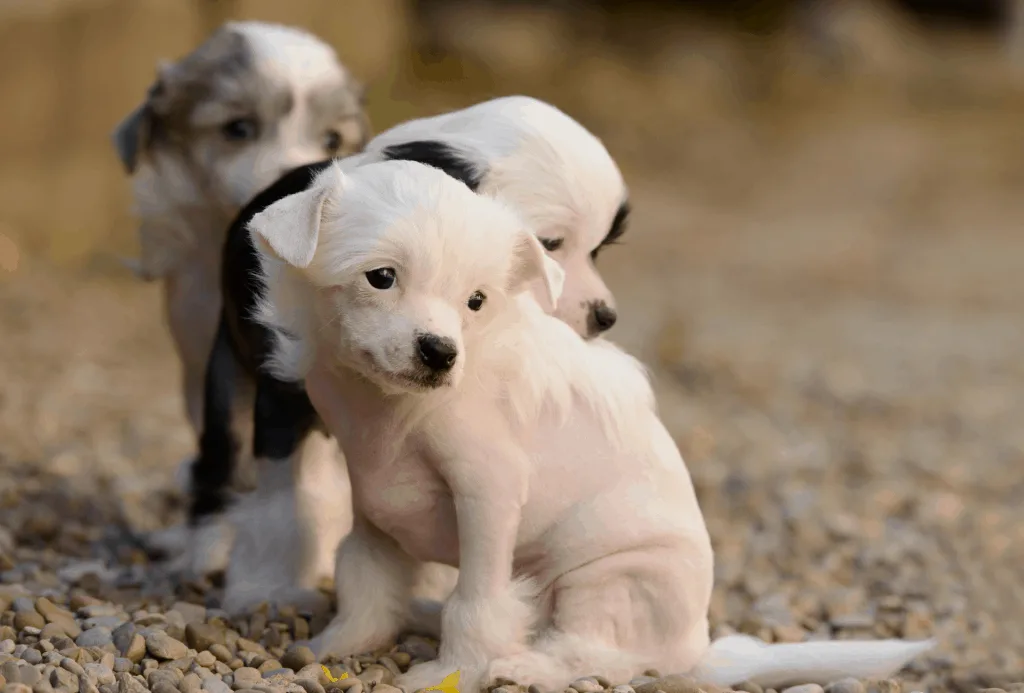
That’s why I always emphasize the importance of an excellent breeder and I have even written an article on the influence that genetics can have on your puppies temperament:
Does Genetics Influence Your Puppy’s Temperament?
Looking at the parents will give you an overall idea of what you can expect from your chosen puppy.
However, it’s also crucial to be clear on the type of dog you would like to have and a responsible breeder can provide you with suggestions as they have been with the puppies for a long time.
For most people, it’s best to choose one that is not extremely excited nor too timid to get out of his corner.
You can see a lot of their fundamental personality traits as early as 4 weeks of age.
How Long Do Chinese Crested Powderpuff Live?
Like a lot of small dogs, the Chinese Crested has a fairly good life expectancy of about 10-13 years. Some can easily life to be 18 years or older.
A dog’s lifespan is influenced by their genetic profile, diseases, exercise, and care.
Longer and happier lives can be achieved by feeding high-quality food, regular vet check-ups, sufficient exercise, and lots of love.
Chinese Crested Powderpuff Health Issues
There is little difference between the hairless and powderpuff when it comes to breed-related health predispositions.
Compared to other breeds that only have a few main health concerns that you should be looking out for.
Health certificates from the parents are necessary to prove that your puppy is genetically healthy and doesn’t carry any hereditary diseases.
The American Chinese Crested Club recommends the following health tests:
- Patella examination
- PRA RCD3 test
- OFA evaluations
- Cardiac exam
- PLL test
The health certificates can be confirmed online by going to ofa.org. Eyes, skin and joints are most in danger of suffering from diseases including:
Primary Lens Luxation (PLL)
Primary Lens Luxation is a heritable disease and describes the displacement of the eye lens as a result of ligament breakage.
Two types can be differentiated: partial dislocation (lens subluxation) or full dislocation (lens luxation).
Symptoms include cloudy or hazy eyes that are very painful and red. If left untreated, the disease could progress to full blindness or glaucoma.
PLL can only be cured by surgically removing the affected lens.
Oral medication can be used to help with inflammation and pain. Without the lens, an eye will see extremely far-sighted so an artificial lens can restore some of that normal vision.
Legg-Calve-Perthes Disease
Legg-Calvé-Perthes is a condition in which the growing bone cannot be sufficiently supplied with blood, causing the head of the femur to deform.
Disrupted blood flow to the hip weakens the bone and it starts to deteriorate.
Lameness and limping often progress gradually over the course of several weeks until your dog’s leg can no longer bear any weight.
Degeneration will cause the hip to collapse eventually and leads to arthritis.
The further the disease progresses the more painful it will become for your dog. Because the disease only affects one hip joint, he will lose muscle mass in the limping rear leg.
It’s commonly seen in small and toy breeds under 20 lbs and mostly affects puppies between the age of 5 to 8 months but it may also start as early as 3 months.
Multiple x-rays will be necessary to monitor the disease ofter time as it progresses.
Surgery may be required to remove the head of the femur. Therapy is then used to manage the pain.
Progressive Retinal Atrophy (PRA)
Progressive retinal atrophy (PRA) is probably one of the worst eye conditions. It’s characterized by gradual retina degeneration which eventually leads to blindness.
The disease will slowly manifest in night-blindness until it also takes your dog’s day vision. Sadly, there is no known cure for this illness.
Dry Eye Syndrome (DES)
DES also known as keratoconjunctivitis sicca occurs when the tear film is unable to produce sufficient amounts of fluid to lubricate the eye which leads to dry membranes and inflammation.
The disease is commonly accompanied by yellow discharge, redness, and pain.
If left untreated, the damage to the tear glands becomes irreversible until they are completely destroyed.
Schirmer tear tests are used to diagnose the condition which can then be managed by eye drops and topical medication that stimulate tear production and reduce inflammation.
Skin Issues
Chinese Crested Powderpuff can suffer from various allergies to pollen, dust, and mites. Atopic dermatitis is a reaction to those allergens and can trigger itchy and inflamed skin.
Seborrheic is another skin condition that can manifest in either dry, flaky or oily skin.
The itching can be very uncomfortable and an excessive amount of sebum can give off a bad smell.
Chinese Crested Powderpuff History
First mentions of the Chinese Crested date back as early as the 17th century.
Hairless dogs lived in various subtropical regions such as Africa where the lack of fur was an advantage.
They had multiple names like Ceylon, Turkish, and Chinese hairless dog. These dogs were brought from Africa to China and decades of crossbreeding reduced them in size.
Sailors around the world loved taking these small dogs on board with them to deter rodents that could be infested with the plague or other diseases.
But they have only comparatively recently gained popularity among breeders in the USA and UK.
In the mid-1900s, two famous women Gypsy Rose Lee and her sister June Havoc promoted them through their wiring and breeding programs.
In 1979 the American Chinese Crested Club was born and it took another 12 years until they were finally recognized by the AKC.
Chinese Crested Powderpuff Genetics
Recent research has shown that the hairless variety of the Chinese Crested is caused by a mutation on the FOXI3 genetic code.
The gene for hypotrichosis (Hr) is a dominant gene and prenatal lethal in homozygotes (HrHr) meaning that every Chinese Crested you find is a heterozygote as the puppies affected by the double hairless gene will be reabsorbed in the womb.
Both long haired and hairless puppies are born within the same litter in a 2:1 or 3:1 ratio.
Chinese Crested Powderpuff Grooming
The Chinese Crested Powderpuff requires a bit more grooming compared to his hairless counterpart. Frequent brushing will be necessary to keep their fur silk and soft.
Contrary to most breeds, the Powderpuff has an undercoat that is shorter than the overlaying fur. This can result in matting and felting pretty quickly.
Pin and bristle brushes are best to deal with this type of coat and I have found a product that has those two brushes combined into one: Hartz Groomer’s Detangling Dog Brush.
Nails should be cut regularly just like any dog. If they don’t wear down naturally, clipping or grinding will be necessary to prevent torn or broken nails.
While you are grooming use the time to check every important part of your dog such as the eyes, ears and skin.
Look out for any changes, rashes, inflammation or other inconsistencies.
Do Chinese Crested Powderpuff Shed?
Powderpuffs don’t shed a lot and even the hairless version loses more hair than you’d think.
But it’s totally manageable especially with frequent brushing and you won’t find fur balls all over the floors.
They are sometimes referred to as hypoallergenic but in reality, this is a very controversial term that I have written a whole article about if you are interested: Why Hypoallergenic Dog Breeds Are a Myth.
Chinese Crested Powderpuff Rescue
If, after reading this article, you have decided that the Chinese Crested is just the right companion for you, adopting one is a great way to start.
I have listed a few rescues that take in Chinese Crested and even some that are specifically founded for this breed:
- Naked Kisses Dog Rescue
- Bare Paws Chinese Crested Rescue
- Bald Is Beautiful Hairless and Small Breed Rescue
- Naked K9 and Small Dog Rescue
- Rescue Alliance
- Crest Care
- Tender Loving Crested Rescue
- Precious Paws Asian and Small Breed Dog Rescue
- Rocky Mountain Chinese Crested Rescue
- We Love Chinese Cresteds Animal Rescue
Chinese Crested Powderpuff Breeders
If you are more comfortable with the idea of buying a puppy, I would advise you to go to the American Chinese Crested Club and look at their breeder directory.
It is always important to do your own research and carefully screen potential breeders by asking the right questions.
There are several main factors that distinguish between an ethical and non-responsible breeder that I have written more about in the aforementioned link.
Chinese Crested Variations
Besides the hairless and powderpuff there are actually two other varieties, the hairy hairless and true hairless which are just other terms to describe degrees between the powderpuff and hairless.
Only the last two are mentioned in the AKC breed standard.
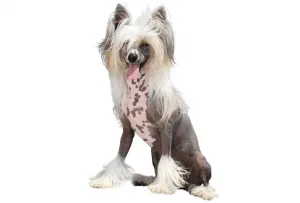
The hairless version is primarily haired on the extremities. Soft and silky fur can grow to any length and the skin is smooth and blueish pigmented (with pink areas) except for the chest patch.
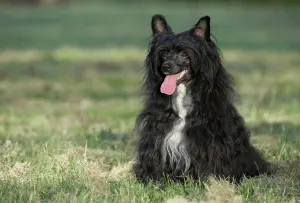
Powderpuffs grow more hair all over the body that can be straight, coarse or curly (the latter is not recognized by the AKC). The coat can be nearly any color like black, yellow, white, blue, or copper.
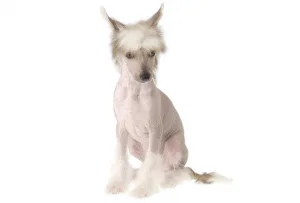
True hairless Chinese Crested come with very little hair on the head, paws and tail. They are also available in multiple colors.
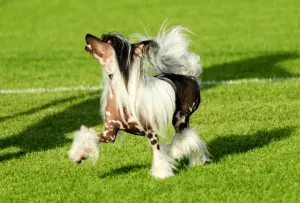
Just like the name indicates, this coat variety has a bit more hair than the hairless Chinese Crested.
Let me know in the comments what you find so interesting about the Powderpuff or you could also write about one you already have.
Recommended Research:
- Chinese crested dog, Roy Robinson, May 1985
- A mutation in hairless dogs implicates FOXI3 in ectodermal development

DonnaSue McCormick
Saturday 27th of May 2023
Rescued a Puff 4yrs ago and he needed extensive work on his teeth and his testicles that were up inside of his body. Never know it now cause he is active, lovable and tries to eat anything without teeth to chew. I also rescued a Maltese in 2015 and he was very aggressive and a biter. He's calmed down a lot and the two boys get along playing and watching over each other. Love them so much 🙏
Phyllis Owens
Wednesday 30th of November 2022
I recused my Chinese crescent when he was 11 months old , he is the powder puff kind . He just turned 15 this month he had and still has a heart murmur. But does great. When we first got this dog he picked how his first love was and you could tell, you could see the love for that person in this dogs eyes. I had never in my life seen love in a dogs eyes before put he had love. I can’t go from one room to another that he isn’t there. If I have to go somewhere he cry’s till I get back home. I can’t go outside by myself that he’s not there. When I get home he will fuse at me foe 15 minutes. But tears will run down his face and I don’t know what to do. I keep his hair cut short due to we live in the country and he love to play outside and roll. Yes he’s 15 and he runs rolls jumps and just has fun. He love toys. Everyone laugh at him because where he was kept in a cage before we got him i guess and he had to hunt for a place to potty he goes around and around like a twirly bird before he poops like if he don’t stop he will fly. But we all love him. The only thing he doesn’t or never has liked small children.
JACALYN FISCHLER
Sunday 7th of January 2024
@Phyllis Owens,
HI - I DECIDED TO READ UP ON CHINESE CRESTED POWDER-PUFFS AND CAME ACROSS YOUR STORY. I HAVE A CHINESE CRESTED POWDER-PUFF AND SHE IS GOING ON 14 YEARS. I WAS GLAD TO HEAR THAT YOURS IS 15. MY COCO, IS ALSO VERY SPRY, PLAYFUL AND ACTIVE. SHE HAS NOT HAD ANY HEALTH PROBLEMS. THE ONLY THING IS THAT SHE GETS INTO EPISODES OF SCRATCHING, A LOT. I HAVE HER ON APIQUIL SHOTS AND IT HELPS. I WOULD VERY MUCH LIKE TO GET ANOTHER ONE. ANY IDEAS WOULD HELP. TAKE CARE!